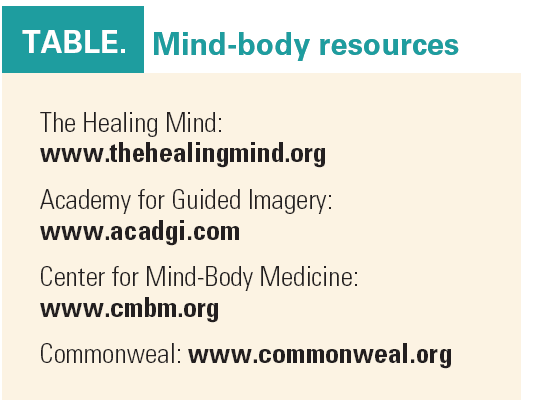Mind-body medicine in cancer care: Making patients whole
A cancer diagnosis carries with it a unique set of challenges for patients, their family, and healthcar e professionals. Patients newly diagnosed with cancer and their support people are frequently in shock, fearful, and emotionally regressed.
ABSTRACT: A physician with an integrative perspective can be critical in helping patients choose the optimal approach to their management and treatment.
A cancer diagnosis carries with it a unique set of challenges for patients, their family, and healthcar e professionals. Patients newly diagnosed with cancer and their support people are frequently in shock, fearful, and emotionally regressed.
During this difficult emotional time, they are called on to make difficult treatment decisions and to evaluate complex information and opinions that often are in conflict, all in an atmosphere of urgency. They can feel pressured to sort through an overwhelming amount of information, and may feel torn between conventional, complementary, and alternative treatment advice.

Finally, cancer patients often are asked to choose treatments that can have difficult, disfiguring, and sometimes life-threatening effects of their own, which makes them difficult to choose, even when they offer potential benefits.
The NIH defines mind-body therapies as interventions designed to facilitate the mind’s capacity to affect bodily function and symptoms. In actuality, all therapeutic encounters have a mind-body aspect. Usually called the placebo effect, it is the most ubiquitous phenomenon in all of medicine. It is an effect that results from the patient’s hopes, beliefs, and expectations, and it can be potentiated or depotentiated by both the physician’s beliefs and the way that physicians communicate. We think it is important for people to be introduced to mind-body approaches as early as possible after their diagnosis for the following reasons:
1. It gives them a positive focus and a sense of participation;
2. It distracts from worrying and catastrophizing;
3. It gives them the message that you think there is reason to hope; and
4. They can learn and practice these skills before their concentration abilities are affected by chemotherapy or radiation.
Major mind-body approaches
A wide range of mind-body approaches allow professionals to help cancer patients and allow patients to help themselves. Below is a list of the most researched and frequently used techniques. Relaxation training. Relaxation techniques utilizing abdominal breathing, muscle relaxation, autogenic suggestions, and simple imagery are the most widely used, easily learned, and generally useful mind-body techniques. Because stress is such a common experience in cancer, reducing it through regular relaxation practice allows a patient to interrupt obsessive worry, regain some sense of control, and create periods of respite from the ongoing challenges of cancer and its treatment.
Guided imagery. Guided imagery is the mental picturing or sensing, thinking, and feeling of a desired outcome or focus of inquiry. It includes a range of techniques from simple visualization and direct imagery-based suggestion to metaphor and storytelling. Guided imagery is used to help teach psychophysiologic relaxation, relieve symptoms, stimulate healing responses in the body, access inner resources, and help people tolerate procedures and treatments more easily.
Social support. Social support and psychoeducational groups consistently demonstrate improved quality of life for cancer patients, and they may contribute to better survival. Feeling listened to, cared for and supported, and learning how to live fully despite a cancer diagnosis are essential components of cancer care. Not everyone benefits from support groups, but almost everyone benefits from support, whether from professionals, family, friends, a spiritual community, or counseling.
Meditation. Meditation involves concentrating the mind on either a neutral or meaningful focus: a word, image, external object, one’s breath, or whatever is occurring at the time. Meditation distracts the mind from worrisome imagery, tends to create a physiologically relaxed state, and helps develop peace of mind. There are many forms of meditation; some are connected to particular religious belief systems, and others are secular and compatible with any belief system.
Biofeedback. Biofeedback uses sensitive physiological monitors to display the reactions the body is having in response to thoughts and feelings. By being able to see, hear, or otherwise experience changes the body makes in response to mental contents, participants can gain control over physical functions normally out of conscious control. When people see how quickly and effectively the body responds to thoughts, it gives them confidence to use their mind to affect their bodies.
Hypnosis. Hypnosis is a term used to describe a state of relaxed focused attention in which response to suggestions is enhanced. While words are used to create suggestions, the most effective suggestions involve mental imagery. In actual practice, guided imagery and hypnosis are often indistinguishable, although people’s beliefs associated with each term can affect their responses.
Interactive Guided Imagery (IGI). This technique is a specific way of using imagery that is particularly effective in helping patients use their inner resources most effectively. Patients are guided to work with their own personal imagery and insights about their illness and healing, clarify any issues that may be involved, and learn to use the mind to support their own healing. IGI principles can be used in self-care approaches but often are best facilitated by a trained health professional, especially where highly emotional issues are involved, as they ften are with cancer.
All of these therapies have the potential to affect the psychological and physical issues that arise in the diagnosis, treatment, and care of cancer patients and their families. Mind-body therapies can make a substantial impact by helping patients and families reduce anxiety and depression, manage their emotions, engage in decision making, reduce adverse effects of cancer treatments and procedures, manage pain, stimulate an immune response, deal with loss, plan for the future, support the will to live, and, if necessary, come to terms with end-of-life issues.
Precautions and contraindications
While mind-body approaches are very safe, especially when compared with most medical and surgical interventions for cancer, there are some precautions to be taken.
We do not believe that the evidence warrants offering mind-body techniques as stand-alone treatment for any cancer, but rather as ways that patients may be able to help themselves and complement medical care.
Patients with mental illness, especially those with a history of psychosis or diffuse dissociative disorders, may be at risk for being overwhelmed by emotional content, especially if explorative techniques are used. Patients who have difficulty distinguishing outer reality from inner experience should work with health professionals who understand these issues and are well trained in both psychology and mind-body therapies.
Our clinical experience has demonstrated that approximately 10% to 15% of mild cases can respond to reassurance and patience, but more severe cases are assisted best by a qualified health professional.
If patients can help themselves by using mind-body approaches, it does not mean that they caused their disease by mind-body error or neglect. Mind-body approaches should offer patients an opportunity to participate in their efforts toward recovery or acceptance and not be construed as “blaming the victim.”

If these precautions are heeded, minimal risk and significant benefit can be had by providing mind-body training and support to people with cancer.
We believe that there is a scientific and moral imperative to provide cancer patients with support and skills that build strength, hope, and psychological resilience. Mind-body interventions offer clear benefits in quality of life and may offer extended survival as well.
Given the low cost, minimal risk, and significant benefits of such interventions, we feel they should be standard of care in cancer treatment.